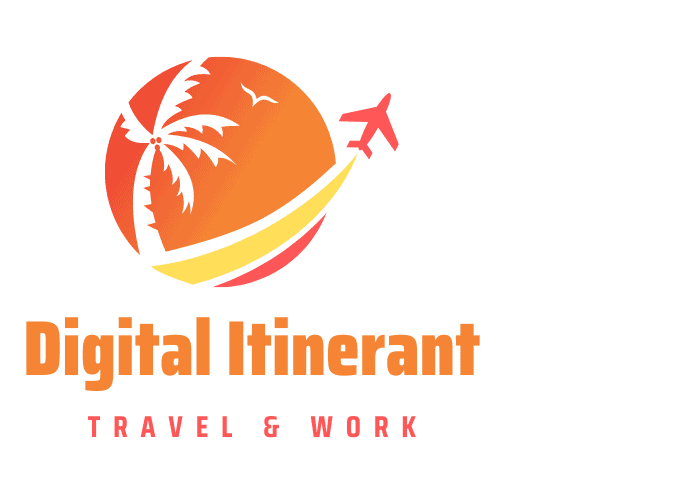Say you have the chance to leave your 9 to 5 job at the office and work somewhere remote, for a year, two, or a lifetime. Where would you choose to go? Many digital nomads dream of living on tropical islands and I don’t blame them, because I do too.
Waking up to the sight of clear crystal waters, surrounded by pristine beaches. Is there a better working space than the natural beauty? Islands like the Caribbean Islands, Rhodes, and Bali have become digital nomad hotspots, and rightly so. They offer digital nomad visas, low cost of living, reliable internet, coworking spaces, and tax-free stay, all the while enjoying tropical beaches and an abundance of natural beauty.
But when it comes to choosing the best island for you, it can be a little overwhelming. Before making the big decision of moving, you should learn everything about the island. From their culture and food to natural disasters, cost of living, and whether you are allowed to stay and work remotely for the desired length of time.
This blog gives a pretty extensive overview of the popular islands so stay tuned and find out which are the best islands in the world for digital nomads and remote workers.
Cayman Islands

One of the best tropical islands for digital nomads are the Cayman Islands. This tropical paradise is a British Overseas Territory in the Caribbean Sea, northwest of Jamaica and south of Cuba.
The popular Caribbean destination consists of three islands, the largest being Grand Cayman. The main island, Grand Cayman, is the ideal destination for digital nomads looking for amazing beach resorts, scuba diving, and snorkeling adventures. Seven Mile Beach is the most significant tourist point, best known for swimming, surfing, jet skiing, and snorkeling. As a digital nomad, you get to work on a white sand beach, and when it’s time for a break you can cool off by swimming with the stingrays or dive deep into the Caribbean Coast admiring fascinating marine life and coral reefs.
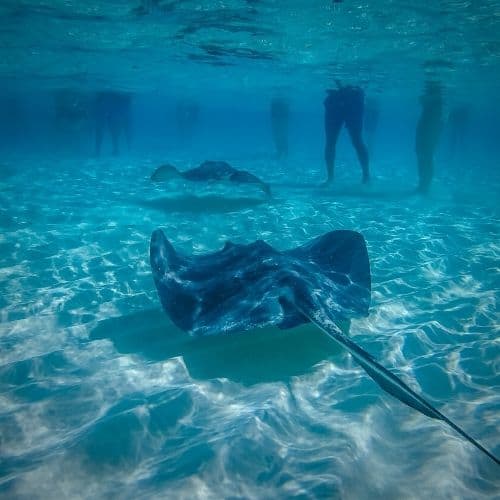
Cayman Brac is the second biggest island, well known for scuba diving, kayaking, deep sea fishing, diving, and snorkeling. Every day you get to see sea turtles, and reefs, enjoy water sports and the gorgeous beaches.
Little Cayman is the small island and least populated. Home to over 2,000 Rock Iguanas, and over 200 species of birds, this little island paradise would be ideal for digital nomads who love animals.

The Cayman Islands digital nomad visa is valid for two years. However, the requirements are pretty high. You must earn $100,000 per year if applying as an individual, or $180,000 per year if applying as a family. This is pretty fair considering the Cayman Islands offer one of the highest standards of living in the world.
Official language: English
Cost of living for a single person: estimated monthly costs are $4,999
Wi fi: The fastest internet speed in the Caribbean with an average speed of 16.12Mbps across all three islands
Best Time of Year: March to June
Length of Digital Nomad Visa: 2 years (read more here)
US Virgin Islands

The US Virgin Islands are another gem in the Caribbean sea, an archipelago made of over 50 small islands and cays. The main islands, and at the same time one of the most popular Caribbean destinations, are St Thomas, St John, and St Croix.
The tropical islands don’t have a rainy season, but some months see more rain than others. Tropical climate, archaeological sights, white sand beaches, and abundant marine life are just a few of the traits the islands offer.

As a digital nomad, you can work from any of the beautiful beaches, and when it’s time for a break put on your scuba diving gear, or go swimming with the dolphins and sea lions. It is the best way to recharge your batteries.
There is no official digital nomad visa for the US Virgin Islands. Since its part of the US, US citizens can travel to the island and live there without any special permit. Non-US citizens can apply for the following visas if they wish to live and work on any of the US Virgin Islands:
- H1B visa
- H2B visa
- Students Visa
Official language: English
Cost of living for a single person: around $2500 a month
Wi fi: fast internet speed, one of the fastest in the Western Hemisphere (25 Mbps)
Best Time of Year: April to June and December to March
Length of Digital Nomad Visa: N/A
Antigua & Barbuda
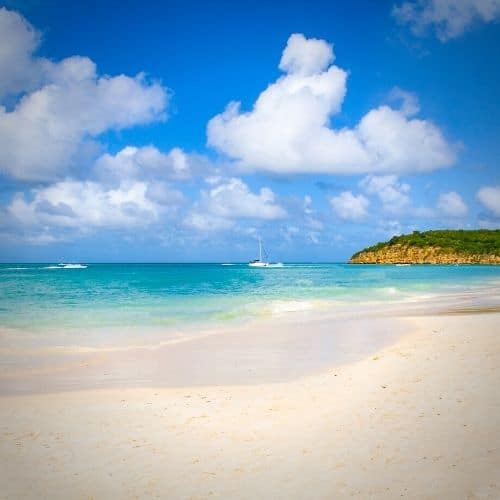
Antigua & Barbuda is a twin-island country in the Caribbean sea made of small islands and two inhabited main islands. The island nation sits in the middle of the Leeward Islands archipelago.
Known for its beautiful beaches, calm waters, but also jungle zip-lining, this beach paradise is perfect for adventurous digital nomads but also for those looking for a relaxing time surrounded by nature.
Antigua is becoming one of the most popular Caribbean Islands for digital nomads and remote workers. This is due to the pretty straightforward digital nomad visa application and the fact that it allows digital nomads and remote workers up to 2 years to stay on the islands.
Anyone can apply for Antigua & Barbuda digital nomad visa (and bring their dependents along with them), as long as they meet the minimum financial requirement of $50,000 income per year. The cost to apply is $1,500 for an individual, $2,000 for two people, and $3,000 for more than two people.
Official language: English
Cost of living for a single person: around $2,200
Wi fi: average 22 Mbps download speed
Best Time of Year: May to November (the off-season)
Length of DNV: Up to 2 years
Jamaica

Jamaica is one of the best Caribbean islands for digital nomads looking to enjoy the eternal sunshine and soft sand beaches, all the while living cheap. Known for reggae, jerk chicken, and Bob Marley, the island of Jamaica is the third largest island in the Caribbean. The mixture of cultures from English and Spanish colonial rule, along with other ethnicities gives the island a unique vibe. Not to mention the delicious cuisine.
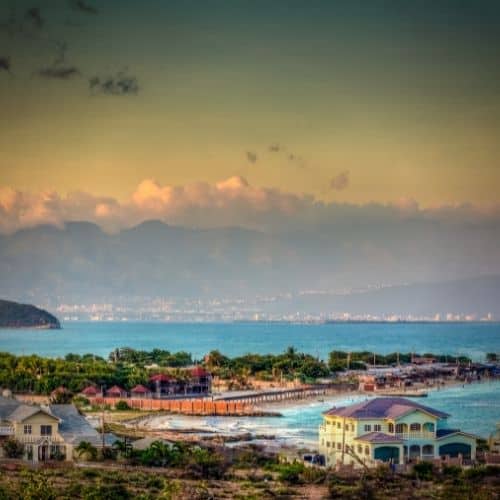
Despite the differences, people in Jamaica live in perfect harmony which is one of the reasons the island has become a favorite spot for expats, nomads, and retirees.
The drawback is the high crime rate, as there are gang-related crimes all over the island. Fortunately, they don’t target tourists but keep your belongings safe whenever you want to pull money from an ATM or avoid dodgy neighborhoods like Spanish Town, Mount Salem, Glendevon, and Rose Heights.
The somewhat large expat community can be found in Montego Bay and Kingston, due to the reliable internet. But there are co-working spots with fast Wi-Fi all over the island. Most of these co-working places are affordable starting at $70 per month and include decent amenities like multimedia projectors, fiber optic internet, admin support, and more.

Living in Jamaica is relatively cheap. Expect to pay $25 for a 3-course meal in a mid-range restaurant, around $100 for utilities, and $450 for a one-bedroom apartment rent in the city center.
Jamaica hasn’t introduced a digital nomad visa, yet. However, anyone is welcome to apply for a long-stay visa, including digital nomads.
Official language: English
Cost of living for a single person: from $650 to $850 per month
Wi fi: 33.78 Mbps
Best Time of Year: December to March
Length of DNV: N/A but they allow digital nomads to apply for a long-stay visa
You can read more about Jamaica for digital nomads here.
Curacao

Curaçao is a Dutch Caribbean island known for its beautiful beaches, each one different from the other. Adventures in Curacao are many, from scuba diving and exploring the coral reefs rich with marine life to casual day tours in the capital, Willemstad, a UNESCO World Heritage Site.
There is a lot to see and do in Curacao, especially the capital, which is a common gateway for digital nomads and ex-pats. The city boasts amazing colorful architecture with most facades in pastel colors. The floating Queen Emma Bridge is an attraction on its own, as well as the 17th-century Mikvé Israel-Emanuel Synagogue.
Curacao is by far one of the best Caribbean islands for digital nomads and remote workers in terms of the low cost of living. When you add the fusion of the Caribbean and European (Dutch) cuisine, culture, and tradition, you get the best of both worlds.
In 2021, Curacao introduced a Temporary Stay Permit for Digital Nomads/Remote Workers under the @Home in Curaçao program. There is no minimum income requirement, which is great news for digital nomads with varying monthly incomes.
You are not required to pay income tax under the @Home in Curaçao program, even if you stay on the island for up to 1 year.
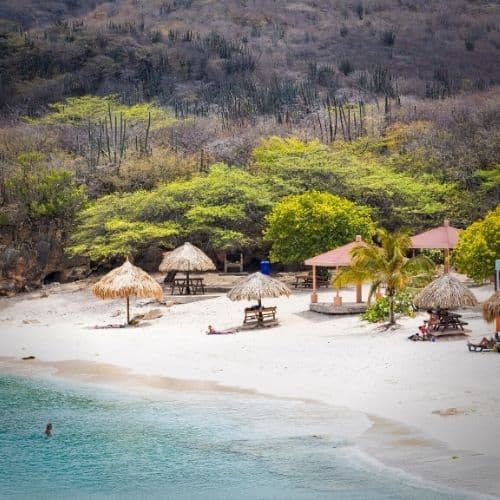
Living in Curacao is affordable for many digital nomads. You can have a meal in a restaurant for $20, roughly $1300 for three-bedroom apartment rent, and around $250 for utilities, including the internet.
Getting around the island is best done by renting a car, as there are only taxis and buses available.
Official language: Dutch, English, and Curacao’s native language Papiamentu
Cost of living for a single person: around $1500 per month
Wi fi: average download speed of 55.97 Mbps
Best Time of Year: May to November
Length of DNV: 6 months, and can be extended for another 6 months
Aruba

Aruba is an island in the Caribbean Sea, part of the Kingdom of the Netherlands (including St. Maarten and Curacao), located 50 miles (80 km) northwest of Curaçao. The island’s location well south of the hurricane belt makes it a desirable destination for vacationers and tourists of all kinds. Aruba is also known as one of the safest places in the Caribbean due to its low crime rates.
In terms of leisure and entertainment, Aruba has an abundance. From tanning on one of the dazzling white sand beaches and wreck diving to colorful architecture and delicious cuisine, Aruba has it all, 365 days of the year. The island is a desert island due to its cactus-strewn landscapes and iguanas everywhere.
Aruba has excellent weather, with more sunny days than any other Caribbean island. No wonder millions of tourists flock to the island each year, paying for expensive vacations just to dip their toes in the crystal clear waters and witness the most stunning and romantic sunsets in the Caribbean.
The Dutch island is part of the Caribbean short-stay visa scheme for digital nomads, which allows travelers to stay for up to 3 months. Citizens of the U.S. are covered by the One Happy Workation program. The program allows them to stay in Aruba, but they are not permitted to work for a company in Aruba. The same program applies to digital nomads who are allowed to stay on the island for 90 days to work remotely.
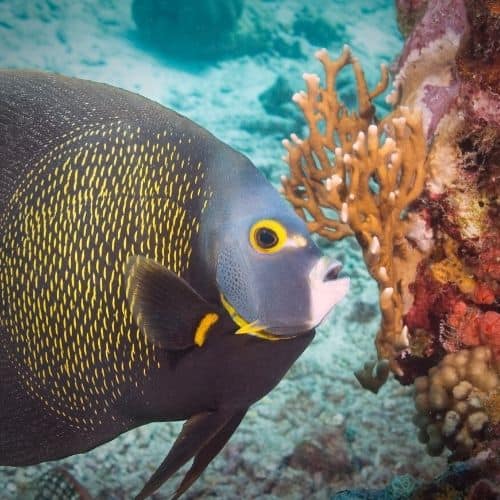
Aruba is not a cheap place to live. A three-course meal will cost you around $30, basic utilities around $200, and roughly $650 rent for a 1-bedroom apartment in the city center.
Official language: Dutch and Papiamento, but most Arubans speak English and Spanish.
Cost of living for a single person: around $4000 per month.
Wi fi: 89.81 Mbps
Best Time of Year: December and March
Length of DNV: up to 90 days
Barbados
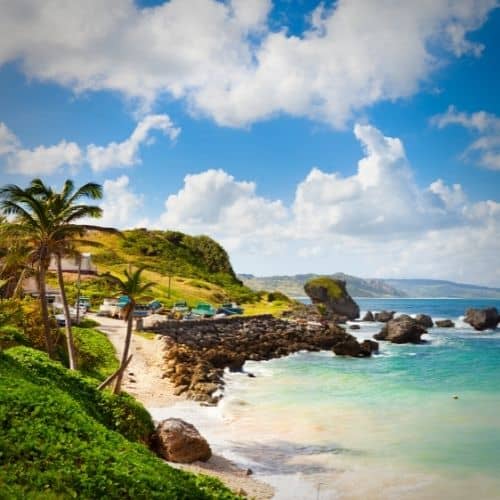
Barbados is part of the Caribbean islands, located close to St Lucia and St Vincent and the Grenadines. Despite the higher cost of living, compared to other Caribbean islands, Barbados is one of the best tropical places for remote work.
Gorgeous beaches with aquamarine waters, dramatic scenery, rich marine life, great weather all year round, excellent quality of life, and fast internet, make Barbados a popular destination for digital nomads. The country introduced a digital nomad visa in 2020, which allows digital nomads to stay and work on the island for 12 months. The price of the DNV is $2,000.
The larger part of the digital nomad community can be found in the bustling capital Bridgetown which is a UNESCO World Heritage Site. Rent in the capital starts from $500 a month, which is not bad compared to the $500 you can easily spend on food.

Official language: English
Cost of living for a single person: $1500 or more for a more comfortable life
Wi fi: fast internet with an average speed of 56.9 Mbps
Best Time of Year: December to April
Length of DNV: 12 months (read more here)
The British Virgin Islands
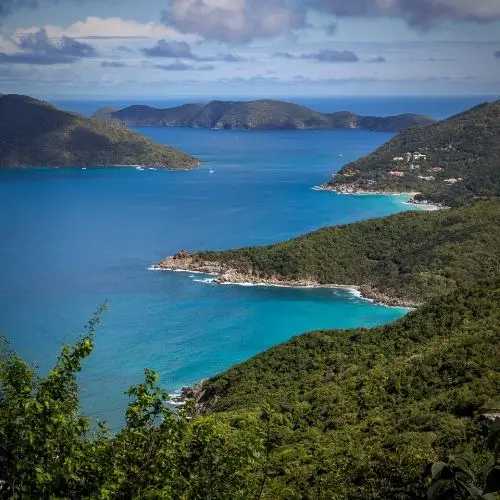
Picturesque landscape, tropical trees, resorts and hotels (too many to count), and of course, tropical white sand beaches to dip your toes in, are what you get on one of the best Caribbean Islands for digital nomads, the British Virgin Islands.
With perfect water sports opportunities, the islands are ideal for digital nomads who love sailing and working at the same time. You can charter a yacht or save some money working from Smuggler’s Cove beach while watching the sea turtles pass you by. Scuba diving is also common, so exploring the coral reefs and stingrays will be like a daily routine.
Baths National Park in the Virgin Jordan is the highlight of everyone’s stay. Being able to visit every day and admire the sea caves and granite rocks is one of the many perks of living on the British Virgin Islands.
The pros of living in the British Virgin Islands are many including a low crime rate, slow pace of life, and exotic beaches. However, all this surreal lifestyle comes at a price. Living in the British Virgin Islands is not easy on the pocket. It is actually a famous destination for luxury travelers. Besides that, and the limited job opportunities, there is a threat of natural disasters like hurricanes, earthquakes, and tropical storms.
The British Virgin Islands don’t offer a DNV, but digital nomads who wish to stay on the islands for up to 90 days do not require any visa as long as they hold a passport valid for at least six months beyond the date of country exit and with one blank visa page.

Official language: English
Cost of living for a single person: With estimated monthly costs of $2500, the BVI is one of the most expensive Caribbean Islands.
Wi fi: 11.91 Mbps
Best Time of Year: December to June
Length of Digital Nomad Visa: N/A
Dominican Republic
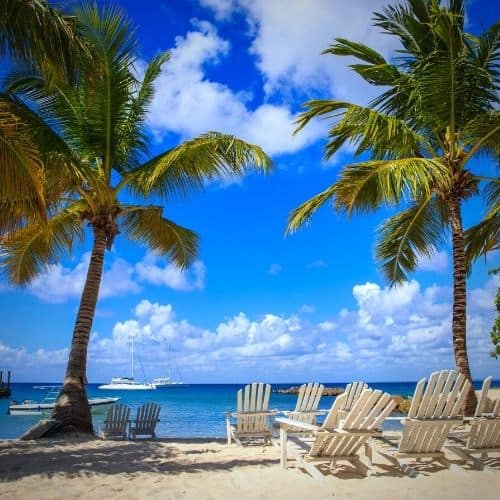
Besides being one of the best Caribbean islands for family vacations, the Dominican Republic is the perfect Caribbean destination for digital nomads from all over the world.
The Dominican Republic sits on the island of Hispaniola, neighboring Haiti to the west. Visitors get to enjoy the tropical beaches, and dream-like resorts and play on one of the many golfing terrains.
If you are feeling adventurous, Dominican Republic has a lot in store for you. From surfing, sailing, and whale watching, to rock climbing, paragliding, and river rafting, the island has a bit of everything for anyone, whether you are a beach person, or a mountain trekker.
For digital nomads looking to make the most of tropical places like this island, Punta Cana would fit the bill. With a 32km stretch of beaches, Punta Cana with its lavish, all-inclusive resorts is the perfect spot for luxury travelers. You can go zip-lining, kayaking, windsurfing, and much other water and sports activities.
But the reason why the Dominican Republic is becoming an ideal destination for digital nomads is that it has the best price-value ratio of all of the Caribbean islands. So, if you are a budget-conscious worker, then Santo Domingo, the capital city, would be the better option, especially if you rent in the historic Colonial Zone. Moreover, Santo Domingo has many co-working spaces where you can have some work done and be a part of the digital nomad community.
As far as visas are concerned, the Dominican republic doesn’t have a specific DNV yet. But that is not an issue since most countries including those from Europe, North, Central, and South America, are allowed to enter the island without a visa. All tourists are allowed a stay of 30 days which can be extended online to up to 120 days.

Official language: Spanish
Cost of living for a single person: $1000 a month
Wi fi: average download speed 18.14 Mbps
Best Time of Year: December to March
Length of Digital Nomad Visa: N/Abut you can stay on the island with a tourist visa
Dominica

An island that often gets confused with the Dominican Republic, which can be an issue when it comes to visas. Unlike the Dominican Republic, which allows visa-free entry to many countries, Dominica requires a visa that allows digital nomads a stay of up to 18 months along with their families. US citizens are not required visa for Dominica, for stays less than 6 months. Other perks of the DNV allow the digital nomad to get a driver’s license and purchase duty-free products.
The island that becomes famous from “The Pirates of the Caribbean”, is located between Guadeloupe and Martinique’s French islands. It’s one of the best Caribbean Islands in terms of natural beauty, for why it’s known as the “Nature Island”. Boasting a diverse landscape that combines mountains, black sand beaches, 365 rivers, lakes, and waterfalls, Dominica is the perfect destination for all nature lovers and adventure seekers.
Moreover, Dominica is home to the Caribbean’s highest peak, the Morne Diablotins, which is 1,447m high. One of the most visited attractions in Dominica is the Morne Trios National Park, a UNESCO World Heritage Site since 1997.
As far as which city is the best for ex-pats and digital nomads, it has to be Roseau, Dominica’s capital, and Portsmouth, the second-largest city. Both cities offer plenty of digital nomad hotspots and large communities, and the cost of living is pretty much the same, with an average monthly rent of $450 per person.
Yes, Dominica is one of the cheapest Caribbean destinations for digital nomads.

Official language: English but French is widely spoken as it use to be a French colony.
Cost of living for a single person: $1000 per month
Wi fi: an average download speed of 54.23 Mbps
Best Time of Year: October to January
Length of DNV: Up to 18 months
Anguilla

If your idea of paradise on Earth involves white sand beaches, turquoise waters, breathtaking sceneries, and romantic sunsets, then Anguilla is the right place for you. Like any Caribbean island, Anguilla is popular for snorkeling, parasailing, scuba diving, and any tropical-place-related activities you can think of. Add the world-class cuisine and you are set for a year.
But at 26 kilometers long and 5 kilometers wide, the island is really small. To come and work remotely in Anguilla you’ll have to consider the size of the island and the small population of 15,000. Also, keep in mind that hurricanes here are common, there is no public transportation and no international flights.
Digital nomads usually like to settle in the capital, The Valley, which has a population of only 1,100. But Meads Bay, Blowing Point, and Sandy Ground are also popular for digital nomads, expats, and families since they are in the heart of everything.
Anguilla offers a digital nomad visa, which allows digital nomads to stay on the island for 3 to 12 months. When it expires, you can reapply again, as long as you still meet the requirements.
There is no minimum monthly income requirement for Anguilla, but compared to other Caribbean islands, the cost of living is not all that cheap. However, with perks like fast internet and low-cost international calls, it is definitely worth a visit.
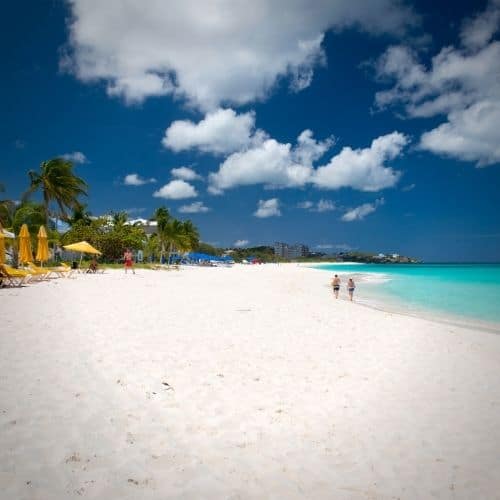
Official language: English
Cost of living for a single person: $4,500 per month
Wi fi: 25 Mbps
Best Time of Year: December to February
Length of DNV: up to 12 months
Sri Lanka (once the country gets more stable)

Elephants, leopards, white sand beaches, rainforests, and more elephants. This is not all there is to Sri Lanka, but it’s a good starting reason for many digital nomads and remote workers to make it their home base.
The tropical island nation of Sri Lanka sits in the Indian Ocean, off the coast of India. Many travelers choose Sri Lanka because of the tropical climate with a year-round temperature of 60-68°F.

Besides the diverse landscape with thick jungles, ancient archeological remains (Sri Lanka is home to eight UNESCO World Heritage Sites), bustling modern cities, and tropical beaches, Sri Lanka is also not an expensive place to settle. Being easy on the pocket without having to sacrifice luxury is one of the main reasons remote workers move to Sri Lanka. The capital Colombo, followed by the mountain town of Kandy tends to be more expensive. The rural you go, the cheaper the cost of living gets (as with many countries in the world).

There is no official Sri Lanka DNV yet, but all digital nomads and remote workers will be allowed to stay for up to 1 year on the island with the DNV. In the meantime, digital nomads who wish to live and work remotely in Sri Lanka can apply for a Sri Lanka ETA visa which will allow them to stay for up to 30 days. They can further apply for a visa extension of up to 180 days while in Sri Lanka. The application for Sri Lanka ETA is done online, and if approved, digital nomads will get the visa on arrival at any Sri Lanka port entry.
Official language: Sinhala, but you can get by with English
Cost of living for a single person: $470 per month
Wi fi: Sri Lanka doesn’t have good internet speeds with an average of 8 Mbps. The internet is faster in most coworking spaces and resorts, but 4G is available on the coast and more reliable too.
Best Time of Year: December – April – Although, there are several climates on that small island. There is always a good spot to go anytime in the year.
Length of Digital Nomad Visa: to be announced but probably up to 1 year
Rhodes, Greek Islands

Greece boasts over 6,000 islands and islets, of which only 227 are inhabited. That means there are a lot of islands for digital nomads and remote workers who like the Mediterranean digital nomad lifestyle.
With an area of only 1,400 km², Rhodes is a small island but the largest of the Dodecanese Islands in the southeastern part of Greece. But what it lacks in space it surely makes up for in history. The island is like a walking museum with ancient ruins across the island from its rich history from ancient Greece to the Crusades and the Ottoman Empire.
There is only one inhabited medieval town in Europe and that is the Medieval City of Rhodes. The Old Town (Medieval City) of Rhodes was named a UNESCO World Heritage Site in 1988. It is a tourist hotspot, with the highlights being the medieval Street of the Knights, the Palace of the Grand Masters, and, of course, the Colossus of Rhodes, one of the seven wonders of the ancient world.
Rhodes can offer a lot to digital nomads who also happen to be history buffs and enjoy beautiful beaches. The island offers spectacular beaches with all the amenities, including spectacular resorts, traditional Greek taverns, bars, and water sports centers.
The island is a popular destination year-round but it’s best to visit from May to October. If you prefer living and working in busy, touristy areas, then the northern coast of the island is best for you. Going south, the island offers a more slow-paced life, calm waters, and peaceful beaches.
You can stay and live on Rhodes for up to one year with the Digital Nomad Visa and apply for a Digital Nomad Residence Permit if you wish to extend your stay. The minimum financial requirement to apply for Greece digital nomad visa is $3,560 per month.
Official language: Greek, but you can get around in English
Cost of living for a single person: around $1000 per month
Wi fi: reliable (in rented apartments) 3.83 Mbps (download speed)
Best Time of Year: May to October
Length of Digital Nomad Visa: 1 year with the possibility to extend
The Canary Islands
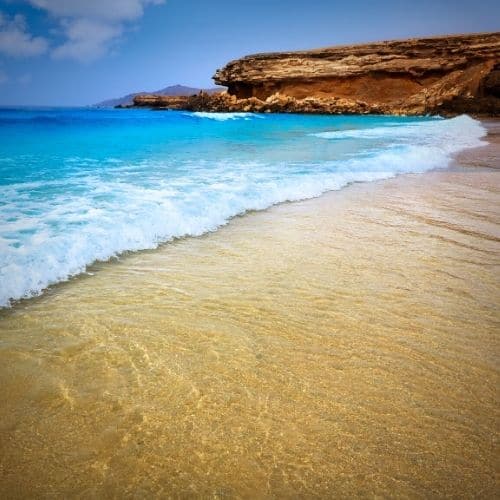
Situated off the Moroccan Coast of Africa, the Canary Islands are made out of 8 main islands of which Gran Canarias, Tenerife, and Fuerteventura are the largest. Despite being 60 miles from the Sahara coast, the islands belong to Spain and are part of the European Union.
The Canary Islands offer a warm climate all year round, which is what attracts digital nomads from across the world to settle for the island life. And being part of the EU allows for easy travel to the island paradise that many digital nomads have made a home away from home.
The digital nomad community on the Canary Islands is growing quickly. There are many co-living and co-working spaces, especially in the capitals of Las Palmas and Santa Cruz and other areas where the expat community is large.
Gorgeous beaches, city life, delicious food, and excellent weather make the Canary Islands a popular destination for remote working.
To apply for a Spain DNV (digital nomad visa), you will most likely need proof of anywhere between $1,500-$3,000 income per month. Since the Spain DNV is yet to be released, all digital nomads wanting to live and work in Spain, including the Canary Islands can apply for the following visas:
- The Spain Schengen Visa
- The Spain Golden Visa
- The Spain Non-Lucrative Visa
Official language: Spanish
Cost of living for a single person: $1,3000 per month for a single person
Wi fi: high-speed internet, mainly in the big cities like Las Palmas and Santa Cruz/ average 50mbps
Best Time of Year: March to November
Length of Digital Nomad Visa: (has not been confirmed yet) but according to the draft version of the Startup Act the maximum stay is 5 years, with all visa extensions
Madeira, Portugal

If you are a digital nomad from Europe and want to escape the long and boring cold winters, Madeira Island is just a short flight from any European country. It is one of the few places in Europe (along with the Canary Islands) with a subtropical climate, the perfect destination for digital nomads chasing sunshine across the globe.
The island is just 520 kilometers (320 miles) west of Morocco, but it’s part of the Portuguese archipelago along with Porto Santo, and the Desertas. The archipelago is a UNESCO World Heritage Site.
Madeira is becoming more and more popular due to its beautiful nature and natural wonders. But the volcanic island is prone to floods, storms, and mudslides.
Funchal is the capital and where you’ll find the largest digital nomad community on the island. Ponta Do Sol and Santa Cruz are other popular digital nomad destinations.
The good news about living in Madeira as a digital nomad is that as of 2021, the Regional Government of Madeira introduced the project Digital Nomad Village. This was aimed to attract digital nomads and qualified workers to the island, provide living, (free) coworking spaces, and events, help nomads settle, and create a community everyone will be beneficial off.
Madeira welcomes all nationalities to live and work remotely from the islands. There is no Portugal digital nomads visa yet. But if you are an EU citizen or a citizen from a visa-exempt country, you can stay and work on the island for up to 90 days without registration. Other nationalities can apply for a short-term visa.
If you want to live in Madeira as an expat, you will have to register with the local immigration office. If you meet the requirements, you will receive a temporary residence permit.
In terms of costs, Madeira is a relatively cheap place for digital nomads to live. A three-bedroom apartment goes for $650, the monthly budget for groceries is around $150 and bills are near $100.
Official language: Portuguese, but English is widely spoken
Cost of living for a single person: $1,300 per month
Wi fi: fast and reliable, around 75 Mbps
Best Time of Year: April to November
Length of DNV: N/A
Koh Phangan, Thailand
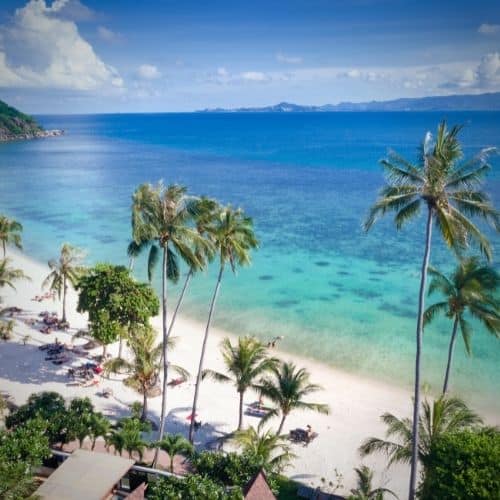
Thailand may not sound like a tropical place but the sandy beaches of Phuket and Koh Phangan, and the bustling city life of Bangkok, along with the low cost of living, are more than enough for digital nomads looking to make Thailand their home base.
The island of Koh Phangan known as the party island has become one of the most popular destinations in South East Asia for remote working. There’s a great digital nomad community here. The island is ideal for remote workers looking for a laid-back lifestyle, yoga, beach life, and parties.
As a result, starting September 1, Thailand will offer a 10-year visa to potential long-term residents. The visa is mainly aimed at workers in high-tech industries, but it will be also available for digital nomads. This is not only great news for digital nomads already based in Thailand and wanting to extend their stay but also for new remote workers who are planning to relocate to Thailand.
In the meantime, digital nomads use the 60-day tourist visa and extend it for another 30 days for a maximum of 90 days in Koh Phangan. But this can further get extended. All it takes is to leave the island and head to a neighboring country and reapply for another tourist visa. This can be done indefinitely as long as the digital nomad continues to meet the requirements.
One of the best perks of living on Koh Phangan is the low cost of living. Digital nomads can get by with $550 a month or $1,000 to live comfortably. Bangkok, the capital, is by far the most popular destination for digital nomads, followed by Chiang Mai, which is less expensive ($1,00o monthly expenses per person). Both cities have large ex-pat communities, many cafes, and coworking spaces.
Official language: Thai, but English is widely spoken
Cost of living for a single person: $550 per month
Wi fi: With fast 4G and 25 Mbps, Thailand has the fastest internet speeds in Asia after Singapore
Best Time of Year: November to April
Length of Digital Nomad Visa: To be announced
Palawan, Philippines

Not an archipelago one would pick easily because of the common natural disasters like typhoons, earthquakes, and floods, but the Philippines are one of those tropical places on Earth that attract millions of tourists each year, no matter what.
Palawan island is the largest island in the Western Philippines. The capital city is Puerto Princesa and where most digital nomads live. It is quickly becoming a digital nomad hotspot, and with its natural beauty, it is no surprise. Factor in the affordable living, lively culture, and welcoming people, and you have the perfect home away from home.
The Philippines don’t have a digital nomad visa available yet. Most western country nationalities get a free visa on arrival, allowing them a stay of up to 30 days. There is the possibility to extend the visa for six months, which is the maximum number of days one can stay in the Philippines. But, you can always do the “border run”, meaning you can fly to a nearby country for a day and re-enter the Philippines.
Most remote workers and ex-pats are located in major cities like Manila, Cebu, and Quezon City, where they can take advantage of better facilities. The smaller islands, although beautiful, are less popular among digital nomads because of the slow internet and common blackouts. It is possible to work from many remote places and small islands but you can be sure that your internet speed and stability will be challenged.
When it comes to monthly costs, one can live comfortably on Palawan for about $800 a month.
Official language: Filipino
Cost of living for a single person: $800 per month
Wi fi: 28.69 Mbps
Best Time of Year: December to February
Length of DNV: N/A
Bali, Indonesia

Out of 17, 000 islands that make up the Indonesian archipelago, Bali is by far the most wanted digital nomad destination, and rightly so. Boasting some of the most fascinating natural wonders, ancient temples, rice terraces, amazing culture, and cheap living, living in Bali is a dream come true for many.
Since the island is located near the equator, the climate is warm and tropical, ideal for warm-weather travelers and digital nomads chasing summer across the globe.
Digital nomads, remote workers, backpackers, expats and anyone looking for a serene life, meditation, and yoga retreats, will love Bali. The high season in Bali means a lot of drunken tourists, especially in Kuta and Seminyak, but there are tons of places where one can sit back and relax, or work in peace like Pura Ulun Danu Bratan and the less popular island of Lombok.
The cultural center in Bali is the town of Ubud. Here you will find a large expat community and many cafes and coworking spaces. One of the best things about the Indonesia DNV is that it allows digital nomads to stay on the island for up to five years and live there tax-free. That is a good enough reason for anyone to pack their bags and swap their monotonous job in the office for one with a view of the mist-draped mountains.
Official language: Indonesian and Balinese, but English is widely used
Cost of living for a single person: from $750 per month
Wi fi: from 512 Kbps – 2 Mbps, faster connection in the coworking spaces
Best Time of Year: April to October
Length of Digital Nomad Visa: 5 years
Mauritius

The African island of Mauritius, just 500 miles (800 km) east of Madagascar is known for its white sandy beaches, volcanic landscapes, and tropical climate year-round. As such, it is often a wanted destination for warm-weather travelers.
This is one of the best places to live in Africa and it is made possible with the Premium Travel Visa which is free to apply for. However, the minimum monthly income requirement is $1500 or $300o if you are applying as a couple.
Digital nomads who have obtained the Premium visa can stay in Mauritius for up to one year, with the possibility to extend for another year. Once you spend 183 days in Mauritius, you become a tax resident and you are liable for taxes.
If you want to settle in Mauritius as a digital nomad, the best area would be the west coast, more precisely the villages of Tamarin and Flic en Flac. You are close to the beach (available to everyone), the pace of living is slower, and there is good internet and ample services among many others. While the busy areas of Beau Bassin and Rose Hill have a lot going on, the traffic can be pretty crazy and annoying.
Nonetheless, Mauritius is a haven for water sports lovers. You can go water-skiing or kite-surfing in between your breaks.
When it comes to cost, you can find crazy expensive, and very cheap rentals, food, and amenities. Since public transportation is poor, it’s best to rent/buy a scooter or a car if you want to explore the island and get to places fast.
Official language: Mauritian Creole, English, and French
Cost of living for a single person: around $700 per month
Wi fi: 20.67 Mbps
Best Time of Year: May to December
Length of DNV: one year and it’s renewable (Premium Travel Visa)
Final thoughts
surely it looks like the Caribbean islands are the most popular digital nomad hotspots. Most have already introduced a digital nomad visa, and others haven’t, allowing for digital nomads to work remotely with either a travel visa or visa-free.
Essentially, when it comes down to choosing the best island for remote work you will have to take a few things in mind, starting with the cost of living and allowed length of stay, followed by monthly income requirement, internet speed, natural disasters, or whether you are allowed to bring your family along.
Whichever island you choose, you can spend as much or as little as you want, make frugal choices if you are on a tight budget, or splurge on lavish resorts and daily water sports and activities, if your budget allows.
Nonetheless, living in a beach paradise and tropical places like these islands, even for a few months is a dream come true for many digital nomads across the world.
